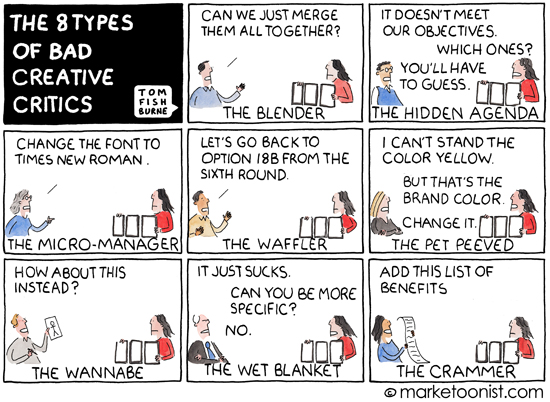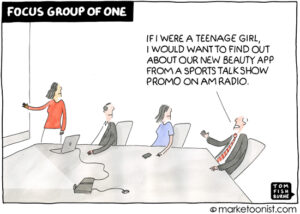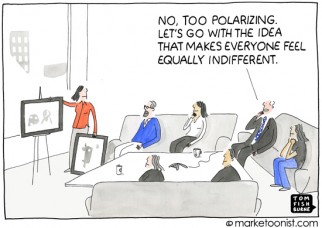I originally drew a version of this cartoon back in 2006 and it’s still one of my more requested and licensed. There’s an ad agency in Australia that has a wall-sized version hanging in the room where they review creative with clients. I wanted to redraw it in color and make it easier to read.
I’ve seen all of these types of creative critics and I’ve been guilty of many of them myself. Learning how to give creative feedback (and how to deal with creative criticism) is one of the most important skills in marketing.
A few days ago, I had the opportunity to spend a day sitting in the writers’ room of a network TV show (co-created by my cousin). I’d always wanted to see a writers’ room in action, particularly to study their creative process (and how they deal with criticism). They have to crank out a new episode every 8 days and there’s a huge group of stakeholders weighing in on every word.
It struck me that there’s a lot an agency or marketing team can learn from a writers’ room. Every business experiences friction between creating and critiquing ideas. A writers’ room is like a masters class on the creative process.
Some of my observations from watching a writers’ room for a day:
-
Creativity is personal. If the ideas are going to be worthwhile, creators have to put themselves out there.
Ideas aren’t precious. You have to grow a thick skin and not take the feedback personally (hard to do when creativity is so personal).
Respect is essential. Especially when people disagree, mutual respect has to underlying the feedback or it breeds resentment.
Ideas aren’t born perfect. One writer may take the lead, but it takes a room to write a script.
Know when to push back. With so many cooks in the kitchen, writers have to navigate a lot of contradictory feedback. They pick their battles.
Find creative solutions to constraints. There were constant hurdles and setbacks to overcome. A production budget might suddenly limit where to set a particular scene, so writers have to rethink why the scene might be somewhere else.
The secret to quality is quantity. The versions and revisions of every script makes the ideas stronger.
Creative executions in an organization are shaped by many hands. I’d love to hear your ideas on how best to give and receive creative feedback.
(Marketoonist Monday: I’m giving away a signed cartoon print. Just share an insightful comment to this week’s post by 5:00 PST on Monday. Thanks!)
Here’s a quick sketch I drew of the writers’ room:




John Dodds says
I think you can do a lot worse than invoke the improv rule of “yes and” which is similar to your “ideas aren’t created perfect” point.
John Dodds says
In an ideal word, it means that bad ideas die of neglect rather than negativity and there’s less bad blood.
Mario Kroll says
Great topic and cartoon. I like the realization that even if we’re in a creative field or creatives ourselves, we may not be the most helpful provider of feedback to other creatives. I’ve most definitely worked with an assortment of clients that fit one or more of these categories, but also provided feedback in several of the ways above, that most likely weren’t always the most helpful or expedient to delivering to expectations.
BC says
Not sure this is always true: “The secret to quality is quantity. The versions and revisions of every script makes the ideas stronger.”
Sometimes different is better… Sometimes different is just different… And sometimes different seems better *only because* it’s different…
Over-thinking, over-reviewing, over-working an idea can make it feel stale to the creator and client of the idea and sometimes a different idea seems better only because it’s fresh.
In a world of limited time and limited budgets, the question is whether or not the 10th iteration, or even the 2nd, will make a big change in the outcome. Had a client for whom I did a lot of writing and he was prone to nitpicking — I actually had to point out once that if we disagreed about something that I created, it’s still a 50-50 split of a sample size of 2. What he didn’t seem to understand is that the investment in rewrite after rewrite to satisfy his one particular view didn’t necessarily move 50-50 to 90-10, or even 51-49. In fact, entirely possible it was “more right” to begin with?
So the point here is to make sure the debate is not limited to those involved in the effort… Your past post (“focus group of 1”) had a comment from a reader about a 42-year-old male judging marketing concepts targeting teenage girls. Input from even one member of the actual target audience would be more valuable than opinions from 10 who are not…
Peter Wilson says
I know you have done this in many ways but to me the biggest barrier to the creative process is doing it by committee. I tend to take the view that unless you take the most senior authority with you through the whole design process then you need to realise that when you present your ideas to them, and only then, are you starting the feedback process! Sad but oft true!
Bonnie Shomette says
Nothing any more disheartening and squashing of some really good contributions from 8-10 people in a group who know from the very first beginning that the ONE carries all the end results in said head and will continuously ‘hear’ from everyone, listens to all the arguments, and then just tells us how it is going to be. So… we just enter the room, sit down and wait, and wait some more, until we have our ideas pulled from us, listen to why not, and hear the end result that we all knew was going to happen. So why the farce of the ‘all hands on deck’, ‘everyone can be heard’ meeting? Something left over from back when, time forgotten, but vaguely remembered so tradition says do it this way, but with the one being heard as the final vote, and the final voice. Ugh! Just stop wasting our time and tell us what you ultimately have decided upon already.
ger says
If your dealing with people who don’t get it save your energy, I think creative workers need to be aware that some people will never get them,my own experience within my own family after decades, if you have an idea give it,if people don’t get it walk, I call it the simple creative s approach
Lynne says
I have actually had someone not liking their own brand colour! The exact same conversation. Reason why I love this cartoon so much…
Aarti says
So how did the writer’s room handle all the various stakeholder’s feedback? I find that in my role, influencing stakeholders and their vision is key to ensuring the value of an idea is not lost in trying to accommodate all the feedback.
Ryan Hose says
It’s funny to look at this and think I’ve dealt with every one of these critics. And it’s a good reality check to realize I may have done some of these myself. I think the best creative criticism offers a promising path to something more interesting and effective or a valid reason why this isn’t the right direction.
Ian Hough says
“Person-as-individual-pain-point” is nothing compared to The Clique of Mediocrity. These people are Satan’s own, and spineless middle-management only enable them in their vile collective delusions.
cecilia t says
in GIVING feedback I think human quality and professional experience is paramount
any feedback should be concise, constructive and helpful. empathize with the one receiving feedback – how would that thing you are going to say help you yourself
any person giving advice should limit to their own competences and experience
– data guys should input precise missing information
– analytics specialists should bring a/b testing results and data – “black button converts 80% better for this audience”
– management should only bring big strategic inputs
in RECEIVING feedback, creative guys should wake up and get out of their hubris
otherwise, accept positive feedback, calmly explain the do’s and the dont’s, the limits and the choices they made, accept changes while not damaging
they can also defend their point of view with solid arguments
all in one, I think that everyone should be less fastidious, more practical and work to get things done rather than get lost in details
Elizabeth Pollock says
Today I’m more self-aware about the feedback I give creative than I was earlier in my career – but I’m sure I’ve been guilty of these feedback pitfalls as a “client” many times! One challenge I currently face is in the method clients provide creative feedback. The company for which I work today provides feedback from the most senior to the least junior “client” in the room, leaving very little room for differing opinions or builds. I was trained the opposite way (starting with the most junior and building to the most senior client in the room). Since I’ve experienced it both ways, I’m curious if there is a preference for creative: would you prefer to hear from everyone or just the most senior client in the room?
Jill says
I love this cartoon and your timing is impeccable! My team will be meeting over the next few days to review our business plans an dcreate a new direction for ourselves. This will require creativity and courage to make it happen! Thanks for my opening!
#ThinkLikeMike says
These types don’t just apply to creatives, they also apply to those of us who work in website development. 🙂
Marti Tedesco says
Nothing makes the creative process go more smoothly than a truly great story line or vision. Whether you are brainstorming as a group, iterating as a virtual group or a group of one or two marketers, you will know when your story “clicks in.” If at any time, the dynamic says you just don’t have “it,” don’t be afraid to go back and brainstorm again. Make it fun, make it inviting, take it offsite, bring in a different energy and keep working until you truly have that aha moment that you are looking for. Sometimes, I bring in an outlier – someone who is constructive but not tightly tied to the project to inject a different perspective.
In my experience, the dominoes tend to fall pretty easily from there especially when combined with the expectation that where you land may not be exactly what any one person envisioned. When the entire team is excited about the direction, then the little pieces of contrary feedback, suggestions or comments are more easily digested.
Manda says
Brilliant cartoon!
As a client I’m very conscious of finding concise and constructive ways to say an idea doesn’t quite fit the bill and why. Defining the ‘why’ and finding the right way to explain it is a skill – no-one should leave the table feeling demotivated – however being frank with agencies makes the process quicker and less painful in the long run, no-one likes wasting time.
Cheryl says
Excellent post! (And comments). It applies to other kinds of client work too.
Crispin White says
Most of these apply to sales or marketing copywriting as well.
I have found a useful feedback format that helps:
Content – have we got all the ideas covered?
Structure – is it in the right order?
Tone – does it sound right?
I wish I had come up with that as it is very useful and helps cut through some of the wafflers, micro managers, wet blankets, blenders, hidden agendas etc.
Amitabh Sinha says
Resonated so much I’m still quivering …… but seriously while it’s sad that this happens everyday, I laughed my head off reading it.
BTW, now we also have hybrid breeds as the 8 traits intermarry and reproduce.
Lau says
Speaks volumes and I don’t work anywhere near the realms of marketing or advertising.
Leah Good says
All. of. them. just. this. year. Oh, and don’t forget #9, the one who disappeared with my ideas in tow, saying “this is so easy, I can do it myself!”